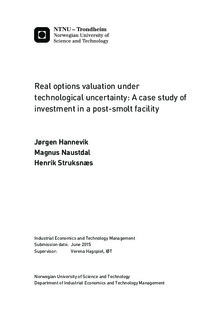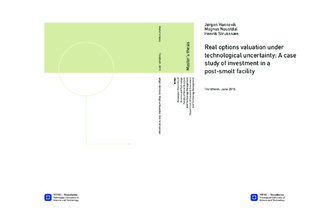| dc.description.abstract | The Norwegian salmon farming industry is struggling with sea lice and diseases. This makes the authorities reluctant to allow an increase in production despite of a growing demand. A measure which can enable better utilization of the existing production limits is post-smolt production. Companies are however hesitant to invest, as post-smolt production is on an early development stage, and there is uncertainty related to the technology and the price development of post-smolt. When uncertainty is high, empirical research indicates that real options analysis is more accurate than the traditional DCF method, which is the industry standard.
In this thesis we examine if multi-factor real options analysis can uncover excess value compared to traditional DCF analysis by evaluating an investment in post-smolt production. Using dynamic programming we develop two multi-factor models enabling us to isolate and analyse the effects of two forms of technological uncertainty combined with profit uncertainty. Technological uncertainty is modelled as the arrival of an innovation that either reduces investment cost or increases production efficiency. The innovation arrival is described by a Poisson process, while profits follow a geometric Brownian motion. To solve the models we develop numerical procedures based on finite differences and algorithms solving sets of nonlinear equations.
Our results show that real options valuation uncovers significant excess value compared to the DCF method, implying that inaccurate valuations could lead salmon farming companies into rejecting sensible business opportunities such as post-smolt production. Our recommendation is however that real options valuation should be used as a complement to, and not a substitute for traditional DCF analysis as the real options models require simplifying assumptions to be mathematically tractable. Additionally we show that the salmon farming company has stronger incentives to delay investment when the benefits of technological innovations cannot be gained if they arrive after the investment is undertaken, implying that investment strategy is greatly influenced by how technological uncertainty is modelled. | |

